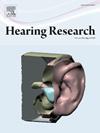Electrophysiological markers of early auditory temporal resolution deterioration with aging
IF 2.5
2区 医学
Q1 AUDIOLOGY & SPEECH-LANGUAGE PATHOLOGY
引用次数: 0
Abstract
Aging significantly impacts auditory perception, particularly temporal resolution, which is the ability to detect rapid changes in sounds. Temporal resolution is often studied using gap detection methods, where a silent gap is inserted into a longer noise duration. Previous research indicates that aging negatively affects gap detection at the behavioral level. To objectively examine this process, electrophysiological correlates can be studied using a multi-deviant oddball paradigm. Existing data show reduced Deviant-Related Negativity (DRN) amplitudes and increased latencies in older adults compared to younger adults, suggesting a pre-attentive decline in processing basic temporal stimulus features. The effects of aging on gap detection have not been extensively investigated, making it uncertain whether changes can be detected in groups with smaller age differences. This study aims to investigate DRN and P2/P3a components in healthy, normal-hearing young (18-25 years) and middle-aged (30-45 years) adults using a multi-deviant paradigm combined with a behavioral gap audibility task with fixed gap durations. While behavioral task results were inconclusive, DRN latency analysis revealed significant differences during adaptation to deviant stimuli between age groups at various gap durations, displaying opposite slopes between both groups. Specifically, middle-aged participants exhibited increasing slopes, while younger participants showed decreasing slopes. Additionally, middle-aged adults exhibited significantly increased P2/P3a latencies compared to younger adults. These findings not only confirm the impact of aging on DRN during temporal resolution tasks but also suggest that examining the P2/P3a component could be valuable for early detection of age-related auditory decline.
老年早期听觉时间分辨能力退化的电生理指标
衰老会显著影响听觉感知,尤其是时间分辨率,即检测声音快速变化的能力。通常使用间隙检测方法来研究时间分辨率,其中无声间隙插入较长的噪声持续时间。以往的研究表明,年龄对行为层面的间隙检测有负向影响。为了客观地考察这一过程,可以使用多偏差古怪范式来研究电生理相关。现有数据显示,与年轻人相比,老年人的异常相关负性(DRN)振幅降低,潜伏期增加,表明处理基本时间刺激特征的注意力前下降。年龄对间隙检测的影响尚未得到广泛的研究,因此不确定是否可以在年龄差异较小的群体中检测到变化。本研究旨在采用多偏差范式结合固定间隔时间的行为间隔可听性任务,研究健康、听力正常的年轻人(18-25岁)和中年人(30-45岁)的DRN和P2/P3a成分。虽然行为任务的结果不确定,但DRN潜伏期分析显示,在不同的间隙持续时间下,不同年龄组对异常刺激的适应存在显著差异,两组之间呈现相反的斜率。具体来说,中年参与者的斜率增加,而年轻参与者的斜率减少。此外,与年轻人相比,中年人表现出明显增加的P2/P3a潜伏期。这些发现不仅证实了衰老对时间分辨任务中DRN的影响,而且表明检测P2/P3a部分可能对早期发现与年龄相关的听觉衰退有价值。
本文章由计算机程序翻译,如有差异,请以英文原文为准。
求助全文
约1分钟内获得全文
求助全文
来源期刊

Hearing Research
医学-耳鼻喉科学
CiteScore
5.30
自引率
14.30%
发文量
163
审稿时长
75 days
期刊介绍:
The aim of the journal is to provide a forum for papers concerned with basic peripheral and central auditory mechanisms. Emphasis is on experimental and clinical studies, but theoretical and methodological papers will also be considered. The journal publishes original research papers, review and mini- review articles, rapid communications, method/protocol and perspective articles.
Papers submitted should deal with auditory anatomy, physiology, psychophysics, imaging, modeling and behavioural studies in animals and humans, as well as hearing aids and cochlear implants. Papers dealing with the vestibular system are also considered for publication. Papers on comparative aspects of hearing and on effects of drugs and environmental contaminants on hearing function will also be considered. Clinical papers will be accepted when they contribute to the understanding of normal and pathological hearing functions.
 求助内容:
求助内容: 应助结果提醒方式:
应助结果提醒方式:


